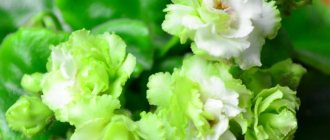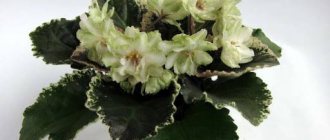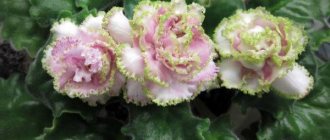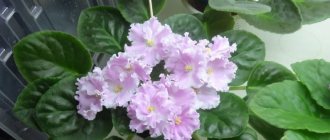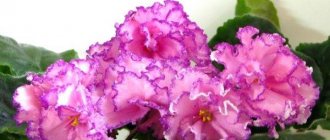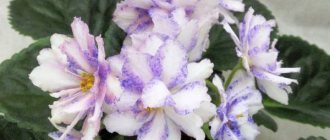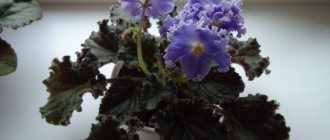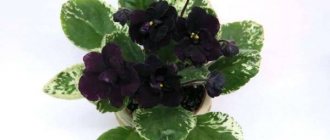Watering and fertilizing
Since the leaves are located close to the soil, it becomes difficult to water the plant.
Water should not be allowed to fall on the rosette or the surface of the leaves, as this can lead to plant diseases. The most effective and safest watering is to immerse the bottom of the pot in a large container. Thus, the bush is saturated with moisture through the drainage holes. In this case, the water must be purified from chlorine and other heavy elements; it is heated to the air temperature in the room. The procedure is carried out up to 2 times a week, in order to prevent waterlogging or drying out, you can do a wick type of watering. Violets must be regularly provided with fertilizers. During active growth, you need to take nitrogen-based fertilizers, and when the first buds appear, use potassium and phosphorus compounds. It is enough to carry out such care about once every two weeks; during the winter, the plant is at rest and no feeding is required. Once every three years, the soil in the container is completely replaced, as it is depleted. Propagation occurs by leaf cuttings, rooting is carried out in water or a ready-made nutrient composition. The container for the plant should be such that it is filled with violet roots. Flowers will not appear until the root system fills the pot. The soil for Esmeralda violets should be loose and light; it can be purchased at a special store.
Rooting a leaf
Next, choose one of two rooting methods: in the ground or in water.
Placing a leaf in water allows you to observe the development of roots, but when planting in the ground it takes some time to adapt.
Rooting in water is done as follows:
- We take water into a disposable cup and dissolve an activated carbon tablet in it;
- We immerse the sheet 1 cm;
- We put it in a warm place, but not in the sun;
- After the roots have formed about 1 cm, we transplant them into the soil.
Violet is rightfully considered one of the most popular indoor plants.
In order for the violet to grow symmetrically, it needs to be turned periodically
When rooting into the ground, we act like this:
- We make small holes in the bottom of a disposable glass to drain moisture;
- Pour in some polystyrene foam for drainage;
- We fall asleep in the ground (recipes above);
- We root the leaf 1 cm;
- Water and keep warm. Possible under film;
- After 1.5 months, new leaves appear.
Violet sprouts with new leaves
When the leaves reach medium size, the violet can be planted in a pot.
Violet Esmeralda: cultivation and care
Violet: planting and care at home, common varieties, methods of propagation
The Esmeralda violet variety requires some care, but knowing its characteristics and if you follow the rules, then growing a bush will not be difficult. In addition, if you create conditions that are comfortable for the violet, the flower will thank you with its beauty. The most important thing is to maintain the level of lighting, temperature, and humidity.
Landing place
The optimal place to grow the plant will be the western or eastern side of the apartment, as this will lead to a sufficient level of lighting. However, direct sunlight will not burn young leaf blades. You can place a pot of violets directly on the windowsill or next to it.
Temperature
The temperature of the room where violets are grown should be approximately 25 degrees or lower. However, the minimum edge is 3 degrees. It is also necessary to ensure that there is no sudden change in temperature, and also to protect the plant from drafts. If the violet is exposed to sudden temperature changes and drafts, it may die.
Humidity
This is a very important indicator of the conditions of the flower, since its level must be at least 50%. If violet is grown in dry air, it will grow and develop poorly. Since the Esmeralda variety is a moisture-loving plant, you can water the entire bush from time to time and give it a warm shower. However, be sure to wipe the leaves with a dry cloth afterwards. To remove dust and dirt, you can wipe the leaves with a damp cloth, but you should not do this very often. Also, to increase the humidity level, you can place a container with moistened pebbles nearby or create a pebble drainage layer. You can simply place a container of water or add moistened perlite to the pan.
This event will not only increase the humidity level, but also protect the bush from some diseases.
Violet Esmeralda: photo
Lighting
Saintpaulias should have an open, illuminated space to avoid burns on the leaves. It is necessary to create a slight shadow or diffused light. However, in the cold season, artificial lighting should be created using special lamps, and the lighting should be at least 15 hours.
Transfer
Among other things, violets require constant annual replanting. The optimal period for transplantation will be spring. It is better to buy ready-made soil, which can be easily purchased at a hardware store. You can also make your own soil, which will consist of peat, deciduous and coniferous humus. It is also very good to add minerals.
When replanting a plant, you must carefully remove the violet from the previous container and, keeping the earthen lump, plant it in a new container. New soil is also added on top. You don’t have to change the container, but you need to completely replace the soil.
In order for the bush to look decorative and the leaves to grow evenly, it is necessary to constantly rotate it around its axis so that the lighting is uniform.
If you provide the necessary care for this crop, namely choose the optimal watering regime, carry out preventive measures against diseases and pests, choose the right place for cultivation, as well as soil, then the violet will delight you with its flowering for a long time.
Feeding
Like any flower plant, violet needs to be fed regularly. Nitrogen-containing preparations, potassium-containing compounds and phosphorus-containing preparations, which are sold in hardware stores, are excellent fertilizers here. Nitrogen-containing preparations must be applied at the beginning of the growing season. This is in the spring or at the time of bud formation. The plant needs to be fed twice a month. In winter, there is no need to feed the violet, since it is in the dormant stage and, in general, the flower should rest.
Watering
Since violet stems are very small in size, and the leaves are located almost on the surface of the ground, moisture can get on them during watering. If this happens constantly, then there is a risk of developing various fungal diseases. Therefore, the plant is not watered from above, so as not to get it on the leaves. Flower growers water the violet from below, namely, lower the pot with the violet into a container filled with water and wait for a while. Once the top layer of soil has become moist, you can remove the container with the violet and drain the excess water, and then return it to its permanent place.
Some gardeners use wick irrigation. To do this, they pull a cord or rope through the holes in the bottom of the pot, and lower the lower edge into a glass of water. Thus, the cord evenly moistens the soil in the pot. Water for irrigation should be warm and settled.
Location, lighting and humidity
All flowers require good conditions for their cultivation. Violets of any variety need a well-lit place. However, we should not forget that flowers, including the “Margaret” variety, can die from direct sunlight and the burns they leave on the leaves.
If you have a lot of violets, it is better to equip them with special racks with artificial lighting. Flowers of this species need 12 hours of full light to produce the hormones it needs.
The best place to place them is windows that face east and west. South-facing windows should be shaded with parchment paper or mosquito netting to create diffused light.
In winter, it is better to remove violets away from heating systems and additionally humidify the air, as it becomes dry, which can destroy these plants. 60–70% humidity is recommended for them.
Margaret's violet should not be placed on southern windows - direct sunlight will leave severe burns on the plant.
Temperature
Drafts are contraindicated for the plant; if they are overcooled, their leaves will curl; if they are overheated, on the contrary, rotting may begin. The most suitable temperature for this species is 17-20⁰ C.
At an acceptable cool temperature and good humidity, the characteristics of the “Margaret” variety appear - the color becomes rich and bright, the rosettes develop densely.
Organization of watering
Many people make the mistake of believing that violets prefer constant moisture. In fact, they can be watered only after the top layer of soil has dried, that is, as needed. You should not spray them - water on the leaves under the influence of the sun causes burns on these plants.
The pot should not be allowed to dry out or become flooded; this can cause a number of diseases in the plants. You need to water with lukewarm melted or settled water and preferably through a tray. A description and photo of the process will help you avoid a number of problems associated with watering.
Feeding violets Margaret
Margaret violet, like other flowers of this species, require year-round feeding. You should not use universal fertilizers; be sure to use fertilizers only for flowering plants. In winter there is enough organic matter; minerals are needed more in the autumn-spring periods. During the formation of inflorescences, phosphorus is needed, thanks to it the flowers become larger and more colorful.
Features of feeding:
It is better to halve the norm indicated on the fertilizer package. Violets need fertilizers that were developed taking into account their characteristics, but you still need to observe the measure: plants will not bloom with excess nitrogen, stepsons and leaves will form intensively, excess potassium can cause yellowing and stunting. growth. It is better to make the feeding concentration 2 times less than what is written on the package (it is better not to feed the violet more than to overfeed it). It is important to choose a complex fertilizer that corresponds to the stage of plant development, and change them from time to time. For the development of rosettes and leaves, young specimens need more nitrogen. For rich flowering and bud formation, add phosphorus. Potassium will prolong the flowering period. Do not allow solutions to get on the leaves. Feed only after watering and only healthy plants. Do not fertilize in bright sun and after transplantation.
Features of care
Violet: description (80+ photos), varieties, care and propagation at home + reviews
Violet Blue Dragon - description and characteristics of the variety
Violet Le Esmeralda is capricious, but with proper maintenance it blooms beautifully and for a long time. The most favorable temperature for it is +18-22 degrees. Do not expose the plant to the air in summer
It is important to prevent differences between day and night temperatures
Place pots of violets on a western or eastern window. The leaves should not be exposed to direct sunlight, as this may cause burns. In hot weather, plants are moved away from the glass. Daylight hours should be long and at least 15 hours a day. In winter, the crop is illuminated using phytolamps.
Bottom watering of violets
Water the violet as the top layer of soil dries. Use warm, settled water. A few minutes after watering, excess liquid is removed from the pan.
Note! Violet prefers bottom watering from a tray. Saintpaulias are not sprayed
Drops of water on leaves cause yellow spots to appear. As a result, the decorative value of the crop is significantly reduced
Saintpaulias are not sprayed. Drops of water on leaves cause yellow spots to appear. As a result, the decorative value of the crop is significantly reduced.
Le Esmeralda does not tolerate dry air well. To increase the humidity levels, water is sprayed from a spray bottle around the violet. In addition, plants can be placed in a tray filled with wet expanded clay.
Priming
The substrate for violets is selected to be light, air- and water-permeable. At a flower shop you can purchase ready-made soil for Gesneria crops. You can prepare it yourself from the following ingredients:
- leaf soil;
- peat;
- river sand;
- perlite
Pieces of charcoal can be added to the disinfection substrate.
Esmeralda inflorescences
Feeding
When planting Saintpaulia in fertile soil, the first fertilizing is done after six months. First, nitrogen is added to promote the growth of green mass. During the period of bud formation, potassium-phosphorus fertilizers are applied. They promote lush flowering.
Note! Fertilizers should be applied to pre-moistened soil.
How Saintpaulia Le Esmeralda propagates
Violet Fairy - description and characteristics of the variety
Hybrid violet is propagated by cuttings (leaves). They are chosen from the 2nd row. The procedure is carried out as follows:
- Strong cuttings are cut with a sharp knife.
- Place in a glass with a small amount of water.
- When the roots appear, the cuttings are planted in a pot with prepared soil.
Leaves can be planted in a container immediately after cutting. They are slightly dried, then placed ⅓ in the ground. The container with cuttings is covered with film to create greenhouse conditions.
The covering material is removed every day, and the container and it are wiped with a dry cloth. If this condition is not met, the plants may become infected with fungal diseases. Soon, babies will grow from the base of the leaves. They are grown and then transplanted into separate small pots.
After the roots appear, the cuttings are planted in a small pot.
Important! Seed propagation can lead to the appearance of characteristics not stated in the crop description.
How to grow it correctly?
Home care for an unpretentious handsome man
In order for Saintpaulia to grow into a beautiful and healthy flower, it needs to create all the necessary conditions.
Where is the best place to place it?
Like any violet, this variety loves light, so it is better to place the flower on the western or eastern side of the room. This way there will be enough lighting and it will be gentle. Avoid direct exposure to sunlight, as this can cause leaf burns.
Priming
The soil for the plant should be loose, contain coniferous, leaf and peat soil
Florists pay attention to acidity, high mineral content, lightness, air tightness, and moisture capacity. Nitrogen content should be in moderation
Pot
Another important detail is the choice of pot for the indoor plant; it should be made of clay or plastic. The diameter of the rosette should be 3 times larger than the upper circumference of the flowerpot, and the height should be equal to the circumference of the pot
Watering
Many inexperienced gardeners encounter violet diseases associated with improper watering. Since the lower leaves grow very close to the ground, and water can get on the base or surface of the leaf, top watering is not suitable for the plant.
For Esmeralda, this method is only appropriate if you need to wash off the salts formed from hard water around the edges of the pot.
Bottom watering is correct for the plant. The pots are lowered into water until the top layer of soil becomes moist. After the excess water has drained off the flower, you can put it back in place.
Some gardeners use the string method; they string a string through the top into the bottom hole of the flowerpot and lower it into a container of water. It is believed that this way moisture is absorbed better and faster.
Light
Saintpaulia is not a very whimsical plant, but each variety has its own characteristics. Esmeralda is an active flower and blooms for a long time, so it needs a lot of light, up to 14 hours a day; if there is insufficient lighting on the windowsill, it can be supplemented with artificial lighting.
Humidity
The indoor flower loves moist air, but it is forbidden to spray it, because its leaves begin to become sore when exposed to water. To provide moist air, some breeders wash the foliage with a shower, but do not forget that they must be wiped dry afterwards.
You can simply wipe off dust with a damp cloth. Such water procedures should be carried out no more than once a month.
Other plant breeders install a drain with pebbles and water near the flower, or alternatively use perlite. All these methods will help create the proper conditions and prevent the occurrence of fungal diseases.
Temperature
Temperature conditions are also important for Esmeralda; during the day the air should be warmed up by +18°...+24°C, and the night temperature should be 4°C lower than the daytime temperature.
Too sudden temperature changes have a detrimental effect on the plant or lead to its disease; you should also not create drafts or sultry heat.
Home care
Competent agricultural technology for growing violets of any type involves regular watering, fertilizers and timely replanting. Some varieties require anti-aging pruning. Let us consider in more detail to what extent and how often these procedures are relevant for LE-Esmeralda.
Watering
Beginning flower growers often encounter violet diseases resulting from improper watering. The fact is that their leaf rosette is placed low near the ground, and the moisture accumulated on the fleecy surface of the foliage evaporates for a long time, thereby provoking the emergence of a pathogenic environment. Therefore, it is extremely undesirable to water the flowerpot at the root.
Surface watering for LE-Esmeralda is only appropriate if you use a watering can with a long narrow spout. When moistening the soil in a pot in this way, you need to make sure that drops of water do not fall on the leaves or in the center of the rosette.
The procedure is carried out carefully and without haste until moisture seeps from the drainage holes of the flowerpot into the pan. According to experts, top watering helps flush out salts accumulated on the edges of the pot, the appearance of which is caused by hard water
The violet needs to be watered from below. To do this, just immerse the flowerpot in a container of water. After moisture appears on the surface of the soil, the flower can be removed from the pan. After waiting for the water to drain, the pot is returned to its old place. Some housewives advise moistening the substrate in a pot using the lace method. Its essence lies in a rope specially provided during planting, which is passed through the drainage hole on top of the pot. With this device, when the pot is placed in a vessel with water, the substrate quickly absorbs moisture.
Top dressing
Fertilizers for this crop are relevant only during the growing season.
They are introduced (depending on the phases of development) according to the following scheme:
- In early spring, nitrogen-containing substances are added to the water to moisten the substrate;
- During the formation of buds, phosphorus-potassium fertilizers are applied every 2 weeks.
Trimming
Chaotic removal of leaves reduces the decorative value of violets. Ignorant pruning negatively affects flowering times and provokes the death of the root system. The fact is that flower stalks are laid in the leaf axils. By cutting them, you disrupt the flowering phase and provoke disruptions in the biochemical processes of the plant, thereby shortening its life. Therefore, it is strictly prohibited to get rid of excess vegetation on a violet bush in this way.
The problem can be solved by replanting the flowerpot, deepening the unsightly place into the substrate. Other flower growers advise cutting off the top of the bush so that a stump 1 cm high remains under the leaves. It is dipped in a container with an aqueous solution of a growth stimulator for several days and after the roots appear, it is planted in a new pot.
It is also important to cut off faded flower stalks and damaged parts of the plant as necessary.
Transfer
The LE-Esmeralda violet needs to be replanted annually. In case of fungal infections, the flowerpot is subjected to this procedure as necessary. It is better to do it in the spring.
For replanting, you will need a light, loose substrate consisting of equal parts of peat, deciduous and coniferous soil.
It is important that this mixture absorbs moisture well, is airtight, and its acidity level corresponds to pH 5.5 - 6.5. In addition, it is recommended to monitor the amount of nitrogen and phosphorus-potassium substances contained
If the proportion of the first ingredients should be moderate, then the second need not be limited.
Experts recommend clay and ceramic products because they allow the roots to breathe, which is of particular importance for a full growing season. However, all violets and Saintpaulias (varieties of violets) are characterized by increased vitality, so they are often rooted in plastic pots.
The process of replanting a flowerpot is carried out by transferring a heavily moistened earthen clod into a new container. Sprinkle fresh soil on top. If the crop is old (and also in the absence of replanting for a long time - more than 2 years), the replanting soil must be completely replaced.
Reproduction
To get a new LE-Esmeralda seedling, you will need an ordinary leaf, peduncle, stepson or cutting. The easiest way to propagate violets is leaf violets. It is best to practice it in spring or summer. For planting, a well-developed leaf of 2 or 3 rosette rows is prepared
It is important that it is not damaged and holds its shape and color well.
Diseases and pests
If signs of violet disease appear, this can only mean one thing - the plant was not cared for correctly. As a result, various diseases may appear.
Powdery mildew
This disease manifests itself as a result of excessive moisture or low temperature. White spots appear over the entire surface of the leaves. For preventive purposes, violets should be treated with sulfur powder or any fungicide.
Late blight
This disease immediately affects both the stems of the violet and its root system, which acquires a grayish-brown tint. In order to get rid of it, you need to remove the plant from the flowerpot and cut off all the affected roots.
Gray rot
When a fluffy gray coating appears on a violet, this can lead to the rapid death of the entire plant. At the first signs, it must be transplanted into fresh soil, having previously treated the entire root system with calcium.
Fusarium
This disease appears as a result of sudden temperature changes, or when the container does not match the size of the plant. The roots of the violet immediately begin to rot, as well as the leaves. Fusarium can only be treated with antifungal drugs.
Rust
Rust can appear on a plant only as a result of water getting on the leaves. However, to combat it, it will be enough to simply cut off the affected parts of the violet.
Don’t forget about pests, which also need to be controlled.
Nematodes
Often small worms may appear in the substrate, which cannot be immediately noticed. They take all the juices from the violet, releasing a lot of toxins. Spots immediately appear on the leaves, which after a certain time simply rot. A little later, the entire plant disappears. In this case, it will not be possible to cure Saintpaulia; you just need to destroy it and treat the pot with a disinfectant solution.
Whiteflies
These pests settle on the lower leaves of the violet and entangle it in a sticky web. You can fight it with the help of special drugs, for example, “Actofit” or “Fitoverma”.
Ticks
Such pests most often affect young leaves, which turn gray. In addition, the buds also do not open.
To summarize, we can say that “Esmeralda” differs from its relatives in its rather bright and lush flowers. And if you care for her correctly, she will be able to delight you with this beauty for quite a long time.
For information on how to plant violet “babies”, see below.
Possible problems in growing
Most problems occur due to improper care, but there are also diseases to which Saintpaulias are predisposed. Occasionally, violets are attacked by insect pests.
Problems with leaves
Problems with leaves are most often associated with improper care. Thus, yellowing and the appearance of spots on the leaves are most often associated with hypothermia. Watering with cold water or excess moisture can provoke the development of root or stem rot, causing the leaves to droop and turn black.
Lack of light will cause the cuttings to stretch and elongate. And excess lighting and heat can cause wilting, drying out and sunburn on the leaf part.
Pests
The main parasitic insects that can harm Saintpaulia LE Esmeralda:
- Ticks that cannot be seen with the naked eye. They settle on aging leaves. Traces of their vital activity appear in the form of white dots on the leaves. Leaves affected by mites are cut off.
- Thrips. They can also only be seen under a microscope, but unlike ticks, they can fly. Houseplants most often get pollen or poplar fluff from the street.
- Aphids can kill violets. The external manifestation of its vital activity is the withering of the leaves, which then turn yellow and fall off.
To combat any insect pests, special preparations are used - insecticides, which can be bought at any flower shop.
Diseases
The most common diseases are:
- Powdery mildew (real or downy) is characterized by the appearance of a powdery white coating on leaves and stems. The false variety is also accompanied by brown spots on the leaf blades.
- Rust affects the leaves, which become covered with rusty spots, then the rest of the flower suffers.
- Root and stem rot are the most dangerous diseases that occur in Saintpaulias as a result of hypothermia and/or overwatering. The appearance of this disease is detrimental to plants. If found, the flower can be thrown away, since it cannot be saved, but the pot can be thoroughly disinfected.
Powdery mildew on violet
Signs of improper care
- with a lack of light, new leaves will be lighter and smaller, the petioles will be stretched, the edges of the leaves will bend upward;
- increased acidity or excessive salinity of the soil leads to curling of leaf plates, the same problem occurs with a lack of nitrogen or overwatering;
- light spots on the leaves or their tips hint to the grower that the flower is watered with too cold water or is suffering from sunburn.
It is better for beginners not to start growing this plant; it is worth practicing on more unpretentious flowers.
Saintpaulia Esmeralda fully lives up to its name with its bright double flowers, of which there are many, starting from the first flowering. This variety will definitely decorate any collection. However, it is better for beginners not to start growing this variety, since it is not so easy to cope with.
Dear friends!
I have been breeding large-flowered violets for over 20 years. Over the years, I have accumulated a lot of work experience. I have many unique varieties with unusual colors of flowers and leaves, which have no analogues, for example the varieties: EK-Marigold, EK-Velvet Queen, EK-Martian, EK-Mosaic of Gems and other varieties. I never tire of being amazed at the natural capabilities of violets! When selecting from hundreds of seedlings, only a few remain that are destined to become varieties.
The names of my varieties are written with the prefix EK- i.e. breeder Elena Korshunova. More than 100 EK varieties are officially registered in the American Society of Saintpaulia Lovers AVSA with the assistance of Vladimir Nikolaevich Kalgin. My varieties are popular among collectors not only in Russia, but throughout the world. EK varieties are in the collections of famous breeders: Sorano, Robinson, Turner.
This year I included in the catalog several varietal series obtained as a result of a long selection from a huge number of seedlings grown from sowing seeds from 15 parent pairs! These are the following series: red-flowered with a white border on the petals on crown variegated leaves; pink and blue series on bright cream-pink-green rosettes; several fantasies on colorful rosettes; white-flowered series, as well as dark red varieties with huge flowers on rosettes with unique platinum and gold variegation!
ek-fialki.com
Transplantation after purchase and during reproduction
After purchasing a violet, you should not replant it immediately. It must go through the incubation period in the same container in which it grew in the store. For 14 days, the plant should be protected from the rest; it is advisable to place it in a separate room. This is necessary in order to protect home flowers from diseases and parasites that Saintpaulia can bring with it.
Further transplantation is carried out by transshipment. Transplantation to a new place is carried out once every 2 years, more often, but not less often. The size of the pot should increase slightly each time, but it should not be too deep.
In a large pot, the growth of the plant will slow down, since it will be absorbed primarily by building up the root system. Only after it has entwined the earthen lump will the ground part begin to develop.
Characteristics of the variety “Dn-Kira”
Dmitry Denisenko is a young, but already confidently declared breeder from Ukraine
His varietal violets, for example, “Dn-Wax Lily”, “Dn-Blue Organza”, “Dn-Kira”, “Dn-Sea Secret”, “Dn-Shaman Rose” attract the attention of many lovers of these plants. The varieties bred by Dmitry are compact, have good peduncles and large flowers of various colors from white and pink (“Dn-Zephyr”) to dark purple (“Dn-Paris Secrets”)
The variety “Dn-Kira” was released in 2016. The plant has a compact, neatly shaped rosette. This violet has large (about 7 centimeters) flowers of a rich blue-violet hue with a white border along the edge of the petals. They can be terry or semi-double. The leaves are variegated, slightly wavy at the edges.
Conditions and care
This variety requires bright lighting with additional lighting in winter, but not direct sunlight. In order to get beautiful darkish tips on the flowers, the plant must be kept in cool conditions during the formation of buds. The rest of the time, temperatures of 19-22 degrees Celsius and humid air are recommended. You need to water with water at room temperature, which has previously settled, without getting on the leaves and rosette. Once every 2-3 years, you should update the soil mixture in the pot and apply special fertilizers during the period of active growth.
Indoor violet “Kira” is a charming plant that, with proper care, will delight you with flowers at any time of the year. Thanks to its compact size, it can be successfully grown even on a narrow windowsill. In addition, it is believed that this beautiful flower creates an atmosphere of harmony around itself, neutralizing negative energy.
To learn how to determine the type of violet, see the following video.
What the plant looks like: photo and description of the variety
Saintpaulia has large double or semi-double flowers of a deep crimson hue. The LE-Esmeralda violet differs from other varieties in its green edging, which, as the bud opens, brightens on top, but never turns white, and remains green below; if the temperature is kept cool, the edging will not change color.
The leaves are velvety, uniformly green in color, not curly. At the base they are collected into a neat rosette; as they age, they acquire a slight waviness.
The main difference of the variety is that even the first flowering lasts a long time and produces many flowers, creating a large lush head. Esmeralda is unstable; 1 rosette does not produce identical inflorescences. It can bloom in winter, but the bud takes a long time to open and eventually dies.
There is another type of this variety - this is RS-Esmeralda, bred by breeder Svetlana Repkina. The flowers of this violet can reach 7 cm in diameter, their edges are white, and the color is more saturated towards the center.
Le Esmeralda Lux
An even, moderately green rosette, the leaves are large and slightly wavy. The flowers are large, crimson, burgundy, fuchsia with a white and green skirt. As the bud blooms, the ruffle turns white, but in the cold it can retain its green color.
Bouquet, long-lasting flowering, the violet reveals all its beauty already in the first flower. The peculiarity of violets of this variety is that one plant can bloom in different ways. Photos and descriptions of the variety can be seen above.
Le Esmeralda sport
In appearance, the Esmeralda sport violet is similar to its relative, its main difference from the luxury variety is the foliage, it is curly on the plant.
Transfer
The plant needs to be replanted once a year, and it is best to do this in the spring. You can purchase soil in specialized stores or make it yourself. Its composition must necessarily include the following components: peat, deciduous and coniferous humus. In addition, minerals must be added.
When everything is ready, the plant can be removed from the pot and carefully transferred to a new container. Sprinkle fresh substrate on top. If the violet has not been replanted for a long time, then the soil changes completely. In addition, for good development of the Saintpaulia rosette, the pot must be periodically turned in different directions. This will allow the violet to receive uniform lighting.
Violet is one of the most favorite flowers that grows in many houses or apartments. In order for her to please her owners longer, she needs proper care. And first of all, this is proper watering, as well as protection from pests and diseases.
Fertilizer
Do not forget about the timely addition of nutrients. Fertilizers must be applied with the onset of spring or when the first buds begin to appear. Do this every half month. The only time when nutrients are not needed is winter. During this period, the violet practically does not grow or bloom, but is mostly in a calm state.
Nitrogen substances are introduced first, and then phosphorus substances. Any of them can be purchased at specialized flower shops.
Watering
Since the leaves of Saintpaulia are quite close to the ground, when watering, water can get directly onto their surface. As a result, various fungal diseases may appear. To prevent this from happening, watering should not be done from above.
It's best to do it from below. To do this, place the container in water and wait a little. When the top layer of the substrate becomes wet, you can pull the pot out of the water. After this, it should be allowed to drain a little, and only then put it in a permanent place.
Possible problems in growing Le violets
Violet does not often suffer from diseases and pests, and with proper care this problem can be avoided altogether.
Diseases
Diseases include powdery mildew and leaf spot. Due to powdery mildew, violet leaves become covered with a white coating, and when spotted, brown spots appear. Dew can be cured by washing the flower with soapy water in the shower, and spotting can be treated with fungicides.
Pests
Among the pests that most trouble Saintpaulia are thrips and aphids. Thrips can be transferred from outdoor trees when ventilating a room. They are destroyed with insecticides Akarin or Dantop. Aphids are located on the back of the leaves and are treated by treating them with tobacco infusion or soap solution.
Other problems
Sometimes there may be problems with drying and falling leaves, as well as lack of flowering. At the same time, it is necessary to reconsider existing care measures.
Le violets are beautiful, and every year their varietal number increases, thanks to the work of Elena Lebetskaya. Bright flowers look beautiful in the interior and do not require complex care.
Growing conditions
Let us consider in more detail the growing conditions of this variety.
Other varieties of violets on our website: “Blue Fog”, “Cinderella’s Dream”, “Blue Dragon”, “Lituanika”, “Ice Rose”, “Olesya”, “Summer Twilight”, “Chanson”, “Jan Minuet”, etc. .
Priming
The soil for violets is chosen to be loose. It should contain peat, leaf and coniferous soil. The soil requirements are as follows:
- moisture capacity;
- airtightness;
- absence of harmful organisms;
- acidity pH 5.5 – 6.5;
- nitrogen in moderation;
- potassium and phosphorus in large quantities;
- ease.
Pot
The choice of pot for a violet depends on its size. The diameter of the rosette should be 3 to 1 with the diameter of the top of the flowerpot. Therefore, it is necessary for the flower to cover the pot 3 times.
Carefully! Large pots are not suitable for violets, since they devote all their energy to filling with the root system. The size of the pot is needed - approximately 500-700 ml, possibly less
The height should be 10 cm, the diameter should be approximately the same (from 10 to 13 cm). It is preferable to purchase pots made of clay or plastic.
Lighting
A well-lit place promotes rapid growth and active flowering of the Esmeralda violet.
It is optimal when daylight hours last at least 14 hours. To prolong it, you can use artificial consecration.
Direct sunlight can be harmful to the plant, so you should protect the violet from it.
Temperature
The temperature should be from 20 to 24 degrees. At night it drops 4 degrees compared to the day. Drafts are harmful for violets, but the high temperature characteristic of summer is especially dangerous - the flower dies in the heat.
Indoor violet - description
Indoor violet is a herbaceous perennial plant. It has an underdeveloped fibrous root system and fleshy stems. Depending on the species, the stems can be short, with leaves growing at the roots and forming a rosette, or elongated, branching with a large number of hanging rosettes. The diameter of the stem can range from 6 to 60 centimeters in length.
The leaves are round, elongated or ovate. The base is heart-shaped or simple. The tip is rounded or sharp. The edges are light, slightly rounded or coarsely serrated. The leaves are flat, highly corrugated, slightly wavy or curved in one direction or another.
The leaves are green in color, sometimes with silver or golden hues. Sometimes there are olive, salad, cream, yellow or pink areas on the leaves. Multi-colored areas are located along the edges of the sheet, at the base, or form various patterns. The inner side of the leaf is usually silvery-green, sometimes with a red tint.
